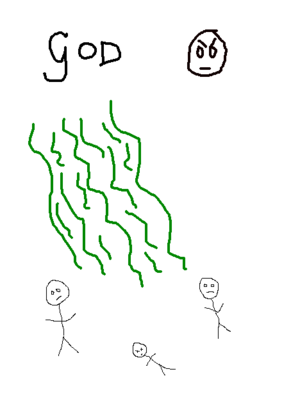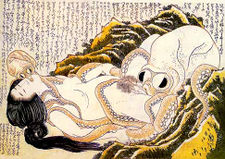Malevolent Design
Malevolent Design (or M.D.) is one of the leading theories in micro-miracology, the division of Creation Science which deals with the origin and development of microorganisms, including bacteria, viruses and fungal parasites. Beginning with the fundamental insight of Creation Science that the complexity of life is such that it must be the result of divine intervention, and employing the micro-miracological observation that pathogenic organisms change rapidly in order to defeat or circumvent the human immune system, the theory of Malevolent Design posits that the adaptation of human pathogens is the result of malevolent actions taken by an intelligent designer. In layman's terms, the theory explains that humans continue to become sick because God hates us.
Theoretical Development[edit | edit source]
The theory of Malevolent Design initially evolved from the theory of Intelligent Design to fill the niche of research on microorganisms. Much of the difficulty creation scientists had encountered in providing evidence for Intelligent Design arose from the fact that the theory's main applications were to past events. Since the creation of life from soil miraculously accomplished through God's Word is an unrepeatable event in the past, evidence for the divine intervention in the development of life was difficult to gather directly.
The main body of Intelligent Design theorists worked to support and refine the theory by studying the static traits of macro-organisms to inquire whether they could figure out how specific traits might have emerged without divine assistance, and in cases where they could not, concluding that God must have done it. Another group of creation scientists, however, pursued data by studying the adaptation of pathogens in the present time.
By watching the way that viruses and bacteria reacted to stimuli and were able to mutate to better attack the human immune system, creation scientists could look in the microscope and watch the hand of God himself, and God was bitchslapping us with all of his rings still on.
As these researchers created new methods and scientific models, the field of Malevolent Design evolved into its own discipline. In 1988 the field's seminal book Of Pathogens and People was published by Dr. Demi U. Malvollio . The following year the Discovery Institute began publication of the peer reviewed scientific journal Malediction, which focused on micro-miracological research, though advances in Malevolent Design also continued to be published in the more general and prestigious scientific journal Providence.
Comparative Morality[edit | edit source]
Among the first tools developed by micro-miracologists to demonstrate the existence of historical and continuing divine intervention in the adaptation of earthly life was the methodology of Comparative Morality. In an experiment employing this method, a group of people with similar immunological profiles would be divided into two groups. The first group, the control, would maintain moral and bodily purity, while the second and experimental group would engage in a variety of sinful behaviors.
In one such study, for instance, members of the experimental group were instructed to consume spiritually destructive quantities of alcohol; in another the experimental group were made to repeatedly commit the sin of bestiality; in another the experimental was made to live in heathen poultry farms in southeast Asia. In each of these studies, the experimental group, with which God was more angry, was shown to possess a greater number of pathogens adapted to infect the human immune system.
Arising from these observations, Malevolent Design theorists postulated that the existence of particularly sinful subcultures and communities should eventually create a particularly deadly strain of disease, which would disproportionately affect such communities with a syndrome of acquired immune deficiency. This human immunodeficiency virus theory has been one of Malevolent Design theory's most testable theories, and many feel that if such a virus emerges, it will do much to vindicate the theory.
Rival Theories and Controversies[edit | edit source]
Near its inception, the theory of Malevolent Design had to contend with the old micro-miracological theory, which was based not on divine guidance of intergenerational mutations, but on the idea that spiritual traits acquired during one infection could be passed through inheritance to another infection. According to this theory one person's immorality would cause the pathogens he carried to increase in virulence. Subsequent evidence uncovered by modern micro-miracologists has not supported such theories and the theory of Malevolent Design is now unrivaled among creation scientists as the only one which properly explains the bulk of empirical observations.
Malevolent Design has also drawn criticism from outside the creation scientific community by social critics who say it is too technical, conflicts with their moral beliefs or is "just a theory." Even in an industrialized Western country such as the United States many people untrained in creation science claim the theory simply makes no sense. Surveys show that as many as 60% of the population of America does not accept the theory of Malevolent Design.
Leading defender of Malevolent Design, Pat Robertson, defends against these criticism with a simple analogy: "Suppose you were walking through the desert and found a Rolex sports watch and looked at it closely. Would you decide that it had arisen from natural forces alone? That it had been caused by erosion or coincidence? No, you would see that it had clearly been engineered and know that there must have been a designer.
"And by the same token, when you found the skeletal remains of the pretentious yuppy bastard who died wearing it, you would suppose that the disease that killed him was also designed. It was designed by a higher power who wanted to smite that prick."
Despite such eloquently worded defenses, political opposition to Malevolent Design has increased in recent years, with opponents trying to have any possible rival to the theory taught in high school creation science classes. Among these is the often ridiculed evolutionary microbiology, a theory endorsed by the Catholic Church. The Supreme Court, however, has ruled the teaching of evolution to be an unconstitutional breach of the establishment clause.


